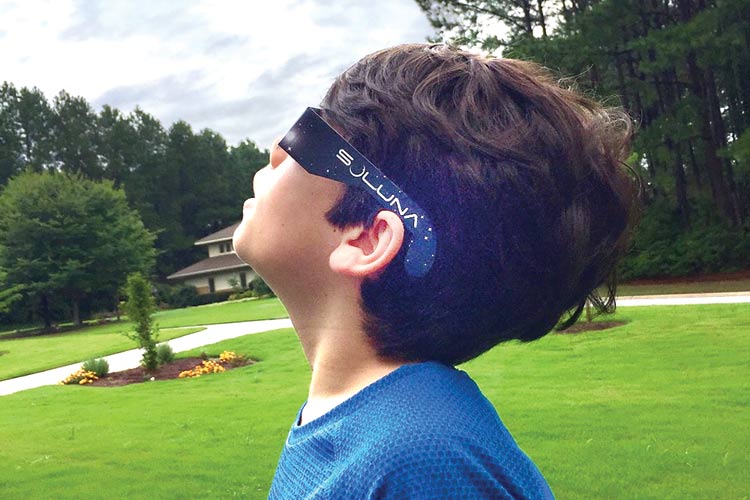By Dr. John Henahan, OD, FAAO
Special to The Citizen
Peachtree City will witness a near total solar eclipse on Aug. 21. With an estimated 95 percent of the sun being blocked by the moon, it won’t be quite as dramatic as the total eclipse in North Georgia, but I am excited to have the opportunity to experience my first near-total eclipse.
As a an eye doctor and a parent, I want to ensure that both my family and our community will have no one become a victim of permanent vision loss from unsafe viewing of this eclipse.
Above, if you’re the son of an optometrist, you are bound to get ready for viewing the Aug. 21 eclipse of the sun with proper eyeware. Here, Liam Henahan, 9, son of Peachtree City optometrist Dr. John Henhan, demonstrates use of a certified-solar-safe set of spectacles. Photo/Submitted.
How does an eclipse damage the eye
The eye has lenses that focus light onto the retina. The retina is a delicate tissue that has millions of rods and cones that turn that light into a chemical signal that your brain converts into vision. The retina is very, very thin (about 2/1000 of a millimeter thick). That allows most light to pass through it and into the rods and cones.
The lenses of the eye focus and concentrate that light onto the retina. This allows us to see all the beauty in the world around us. However, it also can subject the retina to burn damage if the light is too intense.
The rays of the sun are the most powerful natural radiation sources that our eyes are exposed to. It is so intense that normally we cannot look at the sun for more than a few moments before averting our gaze. This is a good thing because it prevents the powerful rays from burning our eye.
During an eclipse however, the sun is much dimmer making it appear that we can safely look for a longer time. Unfortunately, enough light gets through to damage the eye even if the sun is 99 percent obscured. In our area, where the sun is going to be 95 percent obscured at the maximum, there is more than enough light to quickly and permanently damage the retina.
The damage isn’t immediately apparent because the light-sensitive cells of the eye will keep working for several hours after the injury before finally giving out. Everything is badly blurred right in the center of the vision, so they can’t read. They can’t see faces. They can’t see road signs.
This kind of vision loss might get better over several months to a year or it can be permanent.
How to protect your eyes when viewing an eclipse
Regular sunglasses are not enough to prevent damage to the retina. Therefore, special eclipse sunglasses are needed. They are thousands of times darker than regular sunglasses. Due to widespread concern that counterfeit solar sunglasses are being sold, NASA and the American Astronomical Society have a list of recommended manufacturers to choose from. You can find that at: https://eclipse.aas.org/resources/solar-filters.
If you plan on using a telescope or binoculars, you should not wear filters to look through the scope. Instead, you need to purchase a solar filter to fit on your device. The link above provides recommendations if you scroll further down the page.
It has been nearly 100 years since the last total solar eclipse in the United States. With a little common sense and some help from the weather (no clouds please) we can all enjoy one of nature’s great events. Just be sure to use your solar shades.
[Dr. John Henahan, OD, FAAO, lives and practices in Peachtree City. He writes that his wife Lisa and their two children are excited to (safely) see the eclipse of 2017.]













Leave a Comment
You must be logged in to post a comment.